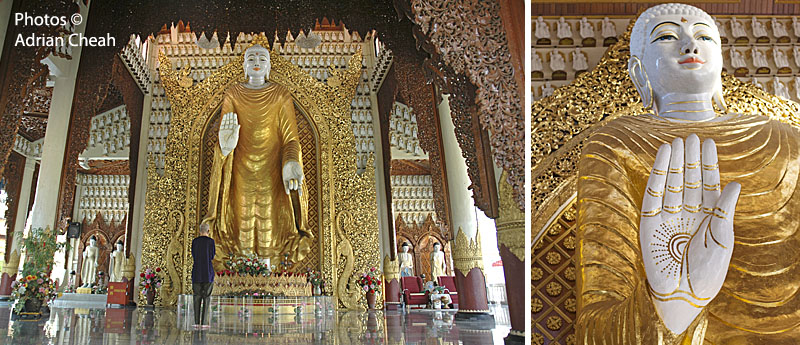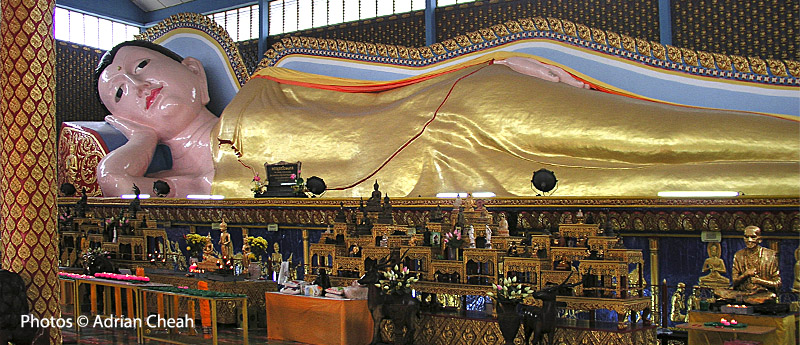Sanctum sanctorums of the Thai and Burmese communities

In 1845, a large endowment of land in the Pulau Tikus area was made to the Theravada Buddhists, principally Thai and Burmese, whose importance is recorded in local street names to this day. Today, the extensive lands surrounding the Thai Wat Chaiyamangalaram are home to a small and thriving kampong of about thirty families (approximately 120 persons) of Thai Chinese and Hindu Indians. (The Changing Perceptions of Waqf, as Social, Cultural and Symbolic Capital in Penang, Judith Nagata)
Dhammikarama Burmese Temple
Burmah Lane, Penang
The 'enclave' at Burmah Lane in Pulau Tikus is home to two magnificent and historical Buddhist temples – one Thai and the other Burmese. The latter was originally known as the Nandy Molah Burmese Temple, the Dhammikarama was the first Buddhist temple to be built in Penang, in 1803.

Like a beacon on a foggy day, the ornate gilded roof of this 200-year-old temple beckons from afar as one walks down Burmah Lane, past the souvenir stalls selling tacky knick-knacks. A pair of stone elephants at the entrance serve as silent reminders of the sanctity within.

Mythical figures and religious icons dot the spacious and well-kept compound – among them bell-bearing acolytes, myriad buddhas, chimeras and flying beings. Two huge and imposing-looking chi lings (a fabulous being that is a hybrid of a dragon, horse and a lion) flank the entrance to the main prayer hall. Chi lings are traditionally used in feng shui to deflect evil, so one could assume that despite their fearsome appearances, the presence of the chi lings at the temple are more for auspicious reasons than sentinel ones!

Next to the remains of a disused 200-year-old well is a huge man-made water catchment filled with carps. Buddha statues in different meditative poses nestle in grottos marked with the names of individual donors. A pair of winged chimeras called Panca Rupa look resplendent in the roles of "Guardian Protectors of the World".


The display to take the breath away is a huge mural depicting the Great Renunciation of Prince Siddharta. The future Buddha is 'captured' riding his steed Kanthaka in mid-air with his faithful servant Channa seemingly hanging on for dear life. Evil beings on one side try to discourage him from his noble quest while the good ones on the other side welcome him with open arms. It's all done very tastefully and the more spiritually inclined may even be moved to contemplate at length on this very significant moment in the history of Buddhism.
Or one could simply choose to make a wish at the wishing pond or meditate under the bodhi tree.


The main prayer hall exudes an air of peacefulness - voices are respectfully reduced to a whisper – but the quiescence is occasionally broken by the ringing of one of the several bells found in the gardens.
Wat Chaiyamangkalaram Thai Buddhist Temple
Burmah Lane, Penang

"I teach the path to immortality." - saying ascribed to the Buddha
Not the oldest, but certainly the largest Buddhist temple in Penang. The colossal size is not within reason, for within the main temple is found the reputed third longest reclining Buddha in the world. Measuring some 33 metres (108ft) from toe to tip of headgear, Wat Chaiya's reclining Buddha takes pride of place alongside other Buddha colossi found in Myanmar, Thailand, Cambodia and China.
The Wat Chaiya was built in 1845 on five acres of land donated by Queen Victoria to the Thai community. The architecture is authentic down to the last bit of gold paint on the pagodas - so much so that one feels transported to another place and time when wandering about the sprawling grounds. Like the Burmese temple across the road, one is likely to encounter mythical beings and religious icons which dot the grounds.
Walking towards the main temple, visitors are greeted by awesome-looking green-faced beings standing guard before the temple entrance. 'Crawling' at their feet are two huge dragon-headed serpents. Unlike the culture in the West (read Caucasian), Oriental mythology teaches that serpents and dragons are propitious beings and not to be feared.

A casual observer might not pay much attention to the different poses assumed by Buddha, but Buddhists believe that the different postures signify different meanings - standing, sitting, or reclining. The significance behind the reclining Buddha in the Wat Chaiya, for example, with the head resting in the palm of the right hand, with the head pointing northwards, signifies enlightenment or Nirvana. Underneath the reclining Buddha lay niches where the ashes of the deceased are kept.
---------------------------------------------------------
Written by Raja Abdul Razak in 2006
Photographed by Adrian Cheah © All Rights Reserved
Photos updated 15 May 2019